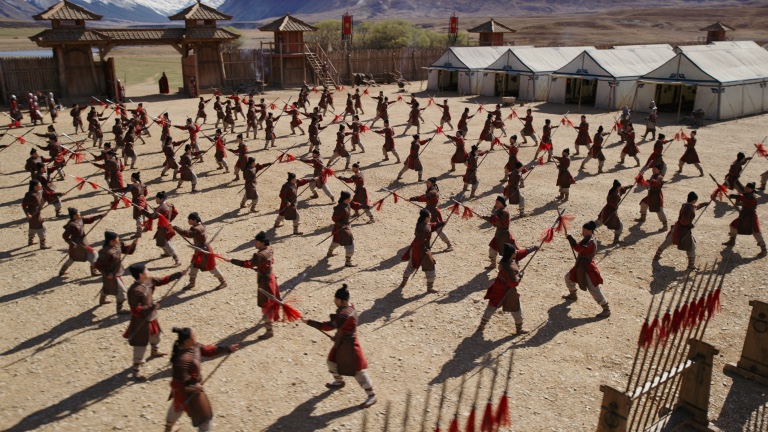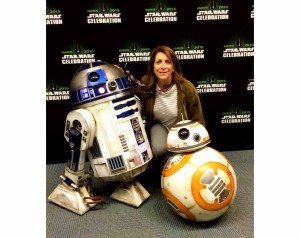
After meeting with Disney CEO Bob Iger and Lucasfilm president Kathleen Kennedy, Abrams was convinced to do the film, the first of three planned sequels to the original three episodes of the series which ran from 1977 to 1983. Of course, assuming anything in the uncertain world of studio productions can lead to disappointment at best. “Is anything ever certain?” Brandon wondered aloud. “Both Mary Jo and I do other films and projects when we are not working for J.J. Being freelance, we take other projects. Wanting to expand our horizons, we like to do other things. It has worked out till now. I took another film when [J.J.] said he wasn’t doing Star Wars. I spent a year trying to apologize. I had a long-term relationship with J.J.”
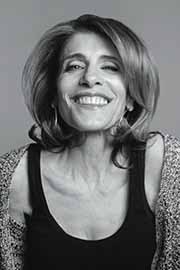
Brandon expanded on the early stages of the project. “We did get a script, and that script kept evolving throughout a lot of the shoot,” she said. “J.J. works that way a lot.”
One unplanned yet ultimately fortuitous event allowed for further evolution of the new film’s screenplay. “When Harrison Ford was hurt,” Markey conveyed, “we had to shut down for a three-week hiatus in the middle of shooting. We shot everything we could shoot without him. It gave J.J. a chance to look at what was shot and cut, what was working, and what wasn’t working as he had hoped. He did a lot of re-writing and re-thinking. I think the film is better than it would have been because that happened. Woody Allen builds in a period when he stops shooting. It would be great if all movies could do that, [but] it’s not that practical.”
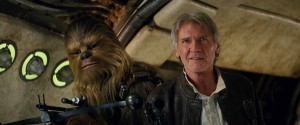
During principal photography, Markey related that she and Brandon watched the dailies together and discussed the scenes in-depth “to see if we were interpreting what we were seeing the same way,” she said. “It is a great thing to have somebody to bounce the ideas off of. Then we go our own ways and cut the material. J.J. pretty much leaves us alone. I had the first part of the movie to cut. I did some work back and forth with him.”
Naturally, with a Star Wars film, many shots require either full visual effects elements or at least enhancement of shots with partial effects, so the editors strove to turn over the movie to the visual effects team as soon as possible to begin the process. As Abrams and his editors had considerable visual effects experience on two massive Star Trek films, they had a methodology in place for Star Wars. “With J.J., he does all of these previzes of all the big action sequences,” said Brandon, though there was a contingency to pre-planning. “He ends up finding it difficult to commit to those. We end up filling in the holes in the visual effects with the visual effects editor and supervisor to figure out where we go from there. Those sequences end up becoming a big team effort in the end and get sorted out.”
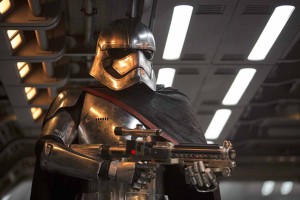 Interestingly, this Star Wars continued effects production through mid-fall of 2015, with a Dec. 18 release date.
Interestingly, this Star Wars continued effects production through mid-fall of 2015, with a Dec. 18 release date.
As production was pushed from the initial start of January of 2014 to that May, Brandon and Markey were both editing other projects while Abrams and Kasdan were re-writing. Then, the pair began to cut Star Wars in Los Angeles for two weeks in May 2014 while the main unit shot the scenes set on the planet of Jakku near the Middle Eastern city of Abu Dhabi, the capital of the United Arab Emirates. Brandon and Markey joined the production in London for location material filmed in England, Ireland, Scotland and Iceland, then on stages at Pinewood Studios outside of London. When production wrapped on November 6 of 2014, Brandon and Markey set up at Abrams’ Bad Robot production offices in Santa Monica, Calif. where they have cut all of his films and where the company’s feature film staff post-produced the film.
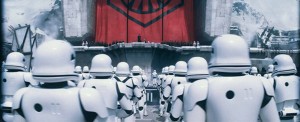 During principal photography, Brandon and Markey would discuss the film in the morning after getting picked up in London and being driven to Pinewood. Brandon noted that they worked at Pinewood every day of production. “We had a cutting room set up near the production office,” she said. “Our first assistants came out to London and did most of the film in London with us — two first assistants and a P.A. the whole time we were in London, and a visual effects person who was also helping out with motion capture. Marty Kloner, our visual effects editor — who didn’t come to London — could cut visual effects and send it back to us.”
During principal photography, Brandon and Markey would discuss the film in the morning after getting picked up in London and being driven to Pinewood. Brandon noted that they worked at Pinewood every day of production. “We had a cutting room set up near the production office,” she said. “Our first assistants came out to London and did most of the film in London with us — two first assistants and a P.A. the whole time we were in London, and a visual effects person who was also helping out with motion capture. Marty Kloner, our visual effects editor — who didn’t come to London — could cut visual effects and send it back to us.”
At the outset, the editors and Abrams meet to divide up the editing duties. “We pretty much divide up the film by the script and decide who’s cutting what,” Brandon said. “We prefer to do whole sequences. We try to take into account the schedule so that it could be divided and everyone could be busy all the time. We can stick with a sequence all the way through, come together, look at the whole, and have a knowledgeable viewpoint on what each of us has cut. You get the best of both worlds.”
Markey explained how she cut the first half-hour of Star Wars: The Force Awakens, then the next full hour was edited by Brandon, and the last half-hour was taken by Markey. “We maintain ownership of our sequences,” she stated. “We talk about each other’s sequences, but each make the changes in our own sequences.”
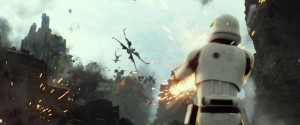 According to Markey, Abrams is the ultimate collaborator in the editing room and will accede to the editor’s choices if they work for the scene. “He may have an idea of how he wants to put a scene together, but he wants to see how we would do it,” she said. “There are things that come out of it that would not come out of it if he said, ‘Start with the master, go into the coverage.’ I would feel so hampered creatively. When you are cutting, one piece of film often organically tells you where to go next — an actor looks in a certain direction; the moment at the end of that piece of film that you just put on, your instinct tells you where to go. That doesn’t happen when someone writes out a plan. That’s not a very organic way to cut a scene.”
According to Markey, Abrams is the ultimate collaborator in the editing room and will accede to the editor’s choices if they work for the scene. “He may have an idea of how he wants to put a scene together, but he wants to see how we would do it,” she said. “There are things that come out of it that would not come out of it if he said, ‘Start with the master, go into the coverage.’ I would feel so hampered creatively. When you are cutting, one piece of film often organically tells you where to go next — an actor looks in a certain direction; the moment at the end of that piece of film that you just put on, your instinct tells you where to go. That doesn’t happen when someone writes out a plan. That’s not a very organic way to cut a scene.”
With the long shooting days that Star Wars required, the editors regularly watched and dissected dailies together without their director. “We have a very open email back-and-forth about what his thoughts are,” said Brandon. “We communicate a lot through email. If he’s worried about a scene, whoever has the scene will put it together as quickly as we can… so that we can refer to them together. He’s always in communication. If I send him an email, I usually get an answer back within minutes.”
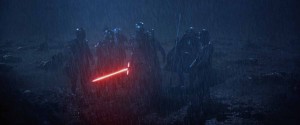 Even during stretches when he is shooting, between setups, Abrams will check emails and other information via a Surface tablet and send feedback to Brandon and Markey in the editing room. “He’s the most awesome multitasker I’ve ever seen in my life,” Markey described.
Even during stretches when he is shooting, between setups, Abrams will check emails and other information via a Surface tablet and send feedback to Brandon and Markey in the editing room. “He’s the most awesome multitasker I’ve ever seen in my life,” Markey described.
Even with a powerhouse effects company as Industrial Light and Magic on the production, Abrams and the editors continued to evolve the effects, even in full effects shots, throughout production and postproduction. “He tends not to commit to the animatics,” Brandon stated of Abrams. Markey added, “We didn’t have more than two-to-three sequences that had previz. He always says to us, ‘Don’t pay any attention to them.’”
Instead, ILM would receive a card from editorial with notes on an effect for a shot that was required, and editorial would receive back an animatic for it, in this case called “post-viz” according to Markey. “You get exactly what you want,” Brandon detailed. “You tell them how many frames you need.”
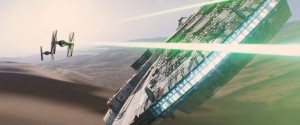 For a full year, from November 2014 to November 2015, Star Wars: The Force Awakens was in the throes of postproduction, with the editors not only cutting the film for drama, but also requiring the integration of numerous types of effects from ILM, now a Disney company, and other vendors. “The visual effects process is slow and painstaking,” said Markey. “We turn over a sequence with the visual effects supervisor, Roger Guyett, and the visual effects editor, and he talks through the scene and what he’s thinking. It’s a pretty open discussion at that point. The shots start coming in. At first, they are very rough looking. It wouldn’t make sense to refine them. We are trying to get a sense on what the action will be like. Things will change completely even if we are far along on a shot. Our visual effects supervisor will come up with some new concept, and we will end up starting all over on the process. There are a couple of CG characters in the film; the design of one of them went on for a long time. It ended up being fabulous.”
For a full year, from November 2014 to November 2015, Star Wars: The Force Awakens was in the throes of postproduction, with the editors not only cutting the film for drama, but also requiring the integration of numerous types of effects from ILM, now a Disney company, and other vendors. “The visual effects process is slow and painstaking,” said Markey. “We turn over a sequence with the visual effects supervisor, Roger Guyett, and the visual effects editor, and he talks through the scene and what he’s thinking. It’s a pretty open discussion at that point. The shots start coming in. At first, they are very rough looking. It wouldn’t make sense to refine them. We are trying to get a sense on what the action will be like. Things will change completely even if we are far along on a shot. Our visual effects supervisor will come up with some new concept, and we will end up starting all over on the process. There are a couple of CG characters in the film; the design of one of them went on for a long time. It ended up being fabulous.”
Brandon additionally explained that Abrams does not review a full version of the film until she and Markey are deep into the postproduction process. “J.J. doesn’t approach the film sequentially. He jumps around,” she said. “He doesn’t want to see the full film until he’s happy with every scene. J.J. takes on a lot of notes and listens to them all. We ended up, toward the last third, trying a lot of different things. A lot of roads didn’t lead anywhere; some roads led to some great things. We would come back around to where we started. We left no stone unturned.”
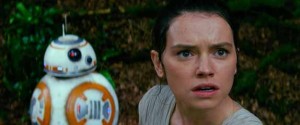 As effects poured in, Abrams, Brandon, and Markey continued to cut all the way through the sound mix in mid-November. The final product was only screened for a few select insiders before the general public was able to view it in mid-December. Brandon and Markey are ultimately very pleased with the results. “There’s nothing like Star Wars,” said Markey. “It’s got a grip on the imagination of the public like no other movie. It’s absolutely unbelievable. It’s mind-blowing to me. I loved doing the Star Trek movies; the first is a favorite of mine. But this is beyond the beyond.”
As effects poured in, Abrams, Brandon, and Markey continued to cut all the way through the sound mix in mid-November. The final product was only screened for a few select insiders before the general public was able to view it in mid-December. Brandon and Markey are ultimately very pleased with the results. “There’s nothing like Star Wars,” said Markey. “It’s got a grip on the imagination of the public like no other movie. It’s absolutely unbelievable. It’s mind-blowing to me. I loved doing the Star Trek movies; the first is a favorite of mine. But this is beyond the beyond.”
Brandon echoed Markey’s sentiments about the project. “It’s great to be a part of something that people are lining up to see,” she said. “How often does that happen in your career? It’s an amazing opportunity and an awesome responsibility, energizing and terrifying at the same time. It’s a living thing.”




